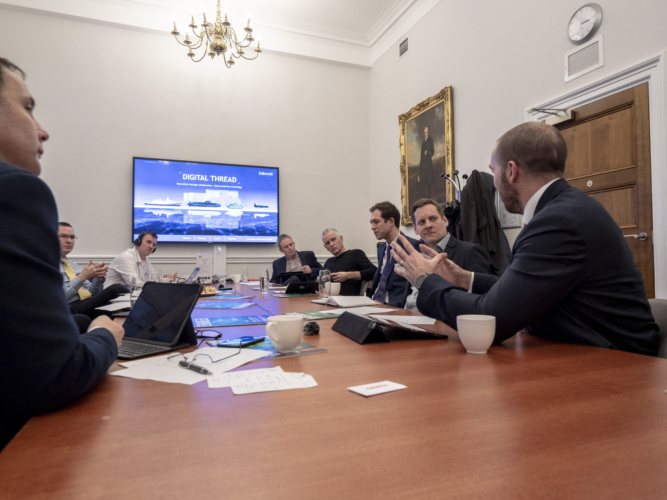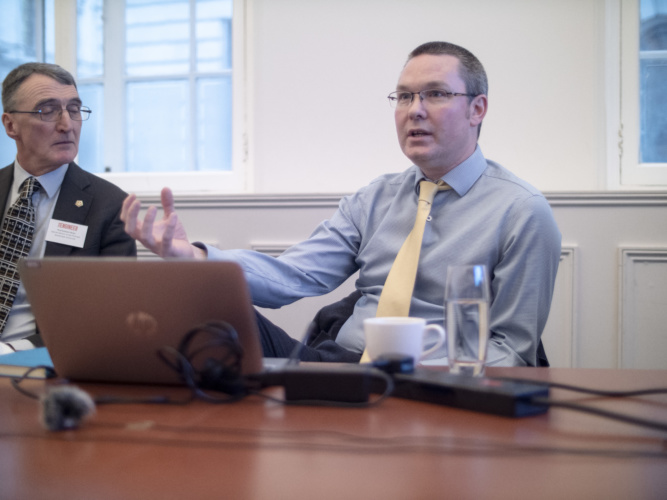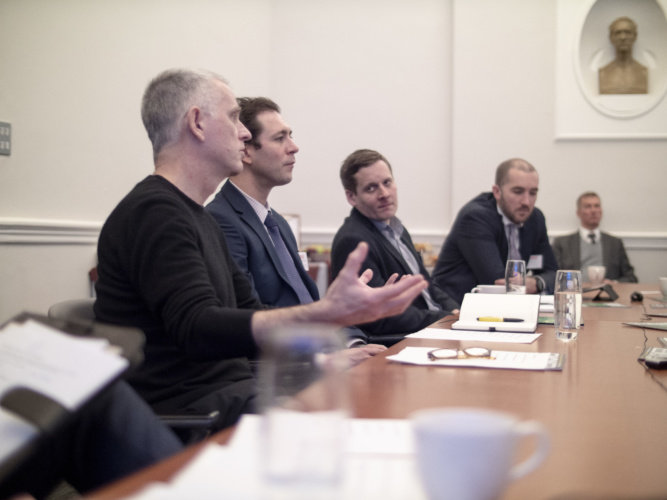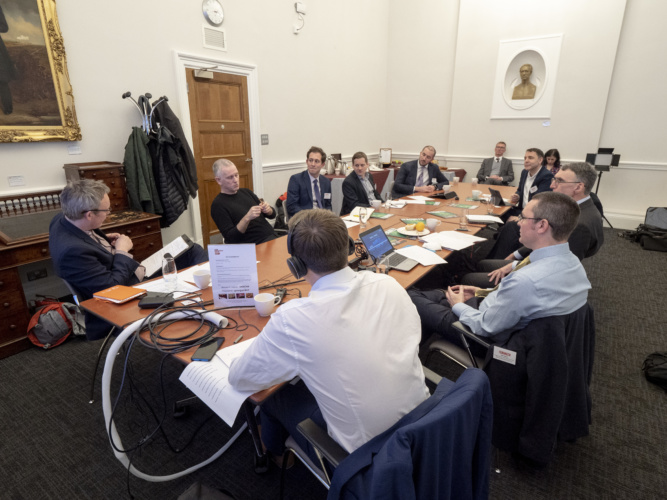
Given the degree to which digitalisation dominates industry discourse, it’s easy to forget that so-called digital tools and processes have been a feature of manufacturing for many decades.
From the CNC machines and computer aided design (CAD) tools that began to proliferate from the 1970s, to the more recent introduction of enterprise-wide product lifecycle management (PLM) tools, digital innovations have been compressing design, streamlining manufacturing and boosting productivity for many years.
But such tools are now just the tip of the digital iceberg. Today, advances in the way we capture, analyse, and share data are leading firms to think not just about how digitalisation can improve one step of a product’s journey but how it can be used to create an all-embracing digital framework, or, to use the current buzz-phrase, a digital thread, that provides a holistic view of an asset’s data across its entire lifecycle: from design and build, through in-service operation, and finally to decommissioning.
The advantages of such a joined-up approach are compelling: enhanced productivity, improved maintenance cycles, optimised operation, and a continuous virtuous loop of information that can be used to refine design processes and optimise manufacturing.
But whilst the benefits are easy to imagine, they’re not so simple to attain in practice. In fact, in a world where supply chains are complex, where cross-disciplinary teams are common, and where the sharing of data and IP doesn’t always come naturally, embracing the digital thread is a mind-bogglingly complex problem.
Earlier this year (January 2020) The Engineer, in partnership with engineering services giant Babcock International, brought together a panel of experts to explore the benefits and the potential of the digital thread, to examine some examples of the digital thread in action and to consider some of the obstacles and challenges to its deployment.
As our panel found, and as the report over the following pages illustrates, whilst there are already some compelling examples of the digital thread in action, there are still many questions. Questions such as is there a greater requirement for open standards? How do you take sceptical members of your supply chain with you? And what technologies and skills are required to put the digital thread into practice?
Meet the panellists
- Neil Young - Engineering & Technology Director, Babcock International Group
- Malcolm Lee – Head of Innovation and Technology, Babcock International Group
- Prof Graham Wren – Special Advisor to the Principal, Strathclyde University
- Prof Dave Robertson – Head of College for Science and Engineering, University of Edinburgh
- Brian Holliday – Digital Director, Siemens
- Chris Greaves - Head of Group IMG and Factory 2050 at AMRC
- Dr. John Ahmet Erkoyuncu Director, Through-life Engineering Services Centre – Cranfield
What is a digital thread?
Setting the scene for the discussion, Babcock’s engineering and technology director Neil Young kicked off with a pithy definition of the concept, and an explanation of why it’s important to the company. “In all of our sectors, Babcock as a business gets involved in the full lifecycle of an asset,” he said, “whether it’s the original design, through to the building and manufacturing of that asset , through to the operations, the in-service support and maintenance and all the way through to the dismantling of the product.”

Young said that this data sharing from one stage of the lifecycle to the next has largely been a paper-based process traditionally, but that being able to share this information digitally - thereby ensuring it’s available and useful at every stage of an asset’s life - has been critical to helping make key decisions in the lifecycle of the warships, submarines, nuclear power plants and other critical assets for which the firm is responsible. “All are very critical and complex assets - how do you make sure you’re making the right decision at every step of the lifecycle – they must be safe, they must be efficient and they must do what the client wants them to do in every single application.”
Chris Greaves, who heads up the AMRC’s Factory 2050 operation, agreed with Young’s take on the definition. “For me, it’s got to be about the cradle to the grave of your product, involving your supply chain, your customers, it’s through-life engineering and it’s end-of-life engineering,” he said.
The panel was also reasonably aligned when considering the benefits of a digital thread. Siemens digital director Brian Holliday put it succinctly when he said it’s about removing the risk of information loss. “For me the digital thread removes the inherent information loss you get when you transition from design, to making something, to operating something,” he said. “It’s about stopping information loss in the first instance, and then building an information set that helps improve your ability to predict things or to improve them when you go back.”
Expanding on why this is important, Babcock’s head of innovation & technology Malcom Lee said: “If you have a digital thread, if you’re able to maintain the continuity of that thread every time it passes an interface, it saves a huge amount of time, effort and money.”
Another key benefit identified by the panel, is the way in which a digital thread can drive improved dialogue and collaboration throughout the supply chain. “When we have goods being delivered to us, we know the quality records of that already,” explained Young. “They’ve been tagged at the supplier with the right coding, they arrive into our stores, and our stores can scan that particular item, we know exactly which compartment of the ship it’s going into….it’s a much more joined together solution. And it’s not about holding the supply chain at arm’s length. It’s about bringing the supply chain into our system and integrating them much more so that they have better information.”
Despite the clear benefits, panellists agreed that getting the supply chain on board isn’t always easy. “One of the challenges for the thought leaders like Babcock is getting the supply chain to see the vision of how it helps them,” said Strathclyde University’s Graham Wren.
Young agreed that clearly articulating the benefits to suppliers is a challenge, and that organisations like Babcock have a role to play in educating suppliers about the long-term benefits of entering into a deeper digital relationship.
https://vimeo.com/395940459
In parallel with this approach, Holliday suggested that there may be some value in mandating digital thread buy-in before contracts with suppliers are signed, although he conceded that “it might be painful to start with.”
Business and economic benefits
One key benefit that several of our panellists alluded to was the ability to have a variety of perspectives across a unified set of data. A digital thread for a complex asset can be interrogated in different ways by different departments, depending on the desired goals.
“Obviously for Type 31 we’ve got a big digital shipyard project happening in Rosyth,” said Neil Young. “What we’re saying is we want one set of data, but the engineer will look at it one way, the supply chain will look at it another way, and have different information to look at and reports coming back.”
Those multiple perspectives will extend to the customer as well. For an asset like the Type-31, the digital thread will provide insight into the various different roles that the frigate will fulfil, beyond its basic functionality as a Royal Navy warship.
“They want something that floats and can move, obviously,” Young continued. “But they also want it to do specific capabilities, whether that’s disaster relief one day, or pa-trolling the Straits of Hormuz the next. That end user experience is the important thing…and the digital thread will feed back into that to make it better.”
https://vimeo.com/395940290
Brian Holliday agreed, pointing out the different requirements of different stakeholders in any given asset. Factory owners may focus on the input and output processes of a given machine, while the suppliers of that asset might be more concerned with its per-formance relative to other machines.
“This notion of multiple lenses into the same digital thread is an interesting issue,” said Holliday. “We shouldn’t gloss over the fact that there is inherent complexity in that but there is utility too.”
That utility on a company level should be relatively apparent, but the benefits to the economy at large could be more difficult to articulate. He pointed to an estimate from Made Smarter of a £455bn macroeconomic boost to manufacturing over a ten-year pe-riod, based on widespread adoption of industrial digital technology.
According to Cranfield’s Dr John Ahmet Erkoyuncu, some of the benefits will come from entirely new business models that digital threads will enable. “If you’ve got a digital thread, you have a lot more understanding of the asset, how it’s performing, he said. “And this means you can move more towards capability-based solutions.
https://vimeo.com/395940509
It could also have significant impact in terms of business models. You could perhaps even sell your digital thread in a licensing-type approach.”
Harmonisation & Open Standards
Our panellists all agreed that open standards and harmonisation will be key to widespread adoption of the technology. “There’s certainly a role for standards in this,” said Malcolm Lee. “From a Babcock perspective we promote open standards and architectures as being very much a key component of this because that is the thing that allows widespread sharing. If you start to have proprietary standards it can make it very difficult for others to utilise the thread.”
“Openness is key,” agreed Brian Holliday, adding that this also opens up digital thread innovation to smaller organisations. “No one company can solve digital, Ecosystems are key, building platforms where a small company can solve a problem in an app with a low code approach that instantly becomes available globally, we don’t think anything of that in our consumer lives but in industry we’ve been that little bit behind. The ecosystem’s key in that the little integrators can now solve problems that in the past we though needed an IBM or Siemens.”
Lee added that open standards will also make it easier to add to the thread at future points in time. “If the standards are open the ability to weave in an additional part of the thread at a future point int time….is manageable. As soon as you start to have closed or proprietary standard you can very quickly run up against economic hurdles…where the cost of the software and the tools required become prohibitive. That’s why we see the open standard as critical.”
Machine learning and AI
Given the huge volumes of data involved, there was widespread agreement amongst the panel that machine learning and AI would play a pivotal role in enabling digital threads.
Graham Wren said that rather than taking humans out of the loop completely, AI should enable better decision making. “Rather than humans poring over endless data, the machine can take you to where you add the most value and provide the most impact to the project,” he said. “The more data you can add to that from similar devices, the greater the accuracy becomes.”
https://vimeo.com/395940393
Edinburgh University’s Dave Robertson sounded a note of caution however, pointing out that digitalisation had the potential to complicate as well as enhance: “A lot of this complexity is because a lot of those kind of tools all got mature at a similar point in time – everywhere you look there’s some damn digital thing that you can then use to possibly make your life better but certainly make your life more complex with data. That’s the Faustian bargain which you have now taken on, and I don’t see how you step back from that.”
Challenges
As for challenges, culture and buy-in featured prominently in the discussion. Encouraging companies to share ownership of data across the supply chain and potentially concede elements of competitive advantage will be difficult.
“The culture of digital thread is one of the biggest challenges,” said Chris Greaves. “It’s going to impact on a group of people that it’s never impacted before and that cultural hurdle is going to be a challenge to solve within your own company, not just in the supply chain and beyond.”
Sharing data with multiple parties also raises questions of trust, which feeds back into buy-in. Businesses need to know they can rely on the data that other parties have access to. Distributed ledger technology (DLT), similar to the much hyped blockchain, could help boost confidence in that shared data and its integrity.

“There’s a role for DLT to help build trust in something that’s inherently untrustworthy,” said Brian Holliday.
“I think blockchain, essentially a distributed ledger approach, could be used in conjunction with cloud technologies, giving the level of trust where you’re starting to make decisions based on machine data in supply chain.”
But as with any new technology, acceptance won’t come overnight. “You want to get to the point where you’re using the data to make valued decisions instead of discussing if the data is wrong,” said Neil Young. “And that will take time.”
Skills
As ever with any engineering discussion, conversation eventually turned to skills. Merging the physical and the digital comes with a unique set of challenges, pushing engineers outside their comfort zones and demanding new capabilities. Finding people with the requisite blend of skills isn’t easy.
“We want this sort of golden goose of an engineer that understands the mechanical but also the programming side,” said Chris Greaves. “It’s a real challenge getting these two worlds to align. It goes right back to what we’re educating people in and where you draw the line between mechanical engineering and computer science. And it is difficult, it’s a grey area. And I’m yet to find a golden goose.”
https://vimeo.com/395940351
An alternative to chasing mythical engineers with the perfect blend of skills is to make sure you have the requisite balance of talent across a team. “I think if you have a team with the right composition and you’re able to lead the team in the right way, then you can bring in the right inputs from the different experts around the table,” said Malcolm Lee. “Going after the golden goose is always a noble quest, but it’s a rare instance that you get there.”
According to our panel, one of the reasons these multifaceted, cyber-physical engineers are nigh on impossible to find, is because the courses to produce them simply don’t exist. With digital becoming embedded in virtually all aspects of engineering, there is a need to rethink how the education system deals with the corresponding new skills demands.
“We still don’t see courses that reflect the sorts of electro-mechanical and data science skills that we want in engineers for the future,” said Brian Holliday. “My own undergrad degree at Cardiff was computer science and electrical engineering and that was as far as it went at the time. I’d loved to have had a dose of mechanical in there as well, but it was the only degree I could find and I haven’t seen that landscape improve.”

There was agreement that university education needs to evolve, but also that businesses need to do more to support continuous development. Outlining the merits of digital training to executives would be a good place to start.
“For me, one of the challenges in skills is the leadership in companies,” said Graham Wren, “getting the CEOs and boards of companies to understand that the world is going to be a very different place, very quickly. They are the people who can make the difference and send people to get trained. So I think the universities and the leaders in the field need to take a particular interest in starting with them.”
Top tips on weaving a digital thread
- When it comes to data collection and digitalisation, automation should be the rule rather than the exception
- Good data collection is essential, but it’s when that data is fed back to improve the asset that the real value is derived
- Go slow to go fast. It’s better to bring everyone along the right path together than move too quickly and leave parts of your organisation behind.
- The ability to clearly articulate the benefits of a digital thread will help bring stakeholders onboard
- Make sure your processes are in good shape before you digitalise. A bad digital process is still a bad process.
- Highlighting the economic impacts will be essential for securing executive and government backing
- Don’t be afraid of the challenge. The change is coming and those who embrace it will benefit.





Swiss geoengineering start-up targets methane removal
No mention whatsoever about the effect of increased methane levels/iron chloride in the ocean on the pH and chemical properties of the ocean - are we...